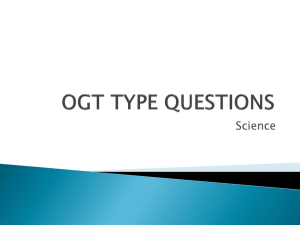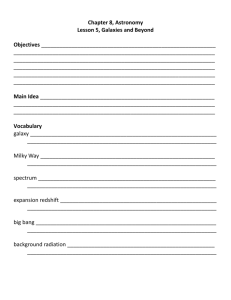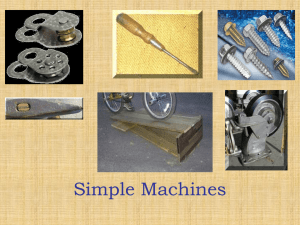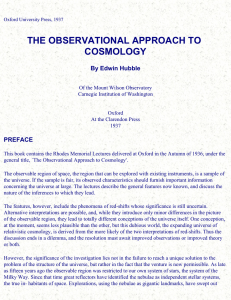Steve Case's Presentation - Mississippi Space Grant Consortium
advertisement
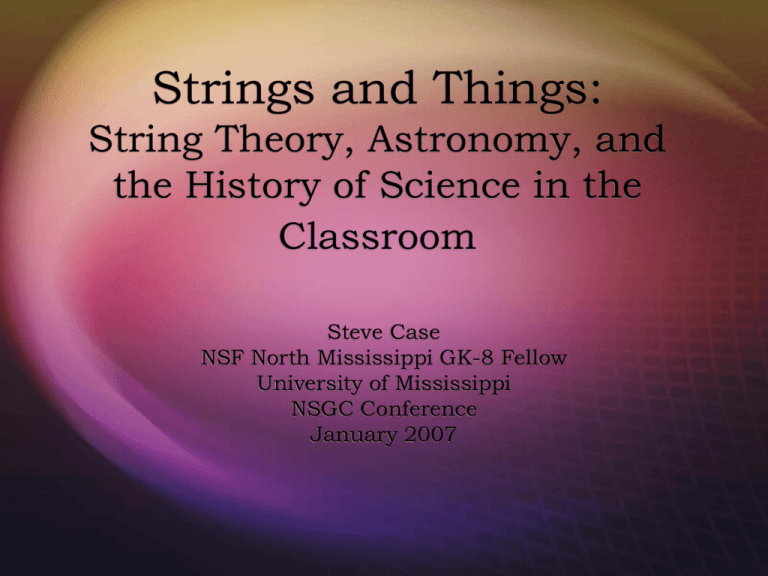
Strings and Things: String Theory, Astronomy, and the History of Science in the Classroom Steve Case NSF North Mississippi GK-8 Fellow University of Mississippi NSGC Conference January 2007 Outline of Talk Summary of GK8 Grant Challenges in science education Examples of GK8 science projects I. The Grant or Who Are We and What Do We Do? NSF North Mississippi GK8 Grant Funded by the National Science Foundation Science, technology, engineering and mathematics (STEM) Oxford and Lafayette county middle and elementary schools Develop projects for the two school districts Project Goals Integrate math and science in K-8 classrooms by implementing projects based on Mississippi Department of Education Frameworks and National Standards. Incorporate the Mississippi River and Mississippi River Basin in projects when appropriate. Include technology in the preparation and presentation of our projects. Develop cross-curricular projects that apply math and science in a variety of different disciplines. Project Goals (continued) Spark interest in Math, Science, Engineering, and Technology. Utilize thematic learning as a teaching tool. Enhance educational practices used by local teachers and graduate fellows creating better teachers locally and within graduate programs. Develop strong and lasting partnerships with fellows, students, schools, and the University. Providing a resource of tested projects available for teachers. Team Composition 12 Graduate Student Fellows 8 disciplines: Mathematics, Biology, Geological Engineering, Chemistry, Physics, Mechanical/Chemical Engineering, Computer Science, and Economics Elementary Team (K - 4th Grades) Middle School Team (5th – 8th Grades) Project Procedure Fellows assigned as project leaders Peer Review Liaison Review Project presented to students Teacher Review Improvement suggestions by teacher Project delivered and approved by project manager Project posted to our website: http://smartweed.olemiss.edu/nmgk8 Outcomes Since June 2003, 314 project have been requested. 262 completed projects posted on the internet II. The Challenges or Where Have We Been, Where Are We Going, and Why Should I Care? Challenges to Engaging Students Disassociation between science and “everything else” No perception of history and development of science as a dynamic narrative No perspective on the overall contemporary scientific landscape, opportunities, etc. Symptoms of a Lack of Engagement: Lack of interest What does this have to do with me? When am I ever going to use this? Why should I care? Lack of appreciation What’s the big deal? Why is it important? Lack of curiosity How can GK8 Projects Help? Science and math presented thematically and in framework of application Focus on concepts and critical thinking leading to the equations and principles Present “story of the science”: people, events, development of ideas behind principles Surveys of current opportunities and research areas in active fields III. The Projects or Light Years, The Great Debate, and Jump Rope Particles Light Years and the Great Debate Eight grade science teacher wanted “something about light years and galaxies” Historical perspective, cross-disciplinary, illustration of narrative of science Frameworks covered: Math 2e: Multiply and divide numbers written in scientific notation. Math 5a: Convert, perform basic operations, and solve word problems using standard measurements. Science 7a: Explain the relationship between distance and light-travel time (light year). Science 7c: Identify and describe the Milky Way as the galaxy to which we belong. Science 7e: Identify and describe spiral nebulae as distant galaxies. Light Years: A Sense of Scope Speed of light Measurement brainstorming Distance to nearest star 25,300,000,000,000 miles 4.2 light years 1 LY = 6 trillion miles = 9.5 trillion kilometers Looking backward in time The Great Debate: Our Place in Space Held in Natural History Museum, Washington D.C. April 26,1920 Between astronomers Harlow Shapley & H. D. Curtis Spiral Nebulae: What are They? Shapley Õ s Universe 1) Spiral nebulae are not galaxies. 2) Spiral nebulae are within or just outside our own galaxy. 3) The sun is not the center of the galaxy. 4) The Milky Way galaxy is the entire universe! CurtisÕ s Universe 1) Spiral nebulae are other galaxies just like our own. 2) These galaxies are far distant from our own galaxy. 3) The sun is the center of our galaxy. 4) The universe is made of thousands and maybe millions of galaxies! It’s a String Thing Request from a seventh grade teacher to create lesson around PBS miniseries “The Elegant Universe” Theoretical physics, general survey of advanced topics, presentation of contemporary issues in science Frameworks covered: Math Framework 1a: Add, subtract, multiply, and divide decimals in real-life situations with and without calculators. Math Standard 3c: Use standard units of measurement to solve application problems. Science Framework 10c: Research one or more of the sources of energy (nuclear, solar, wind, geothermal, hydro). Survey of Contemporary Physics Particle Jump-ropes Summary We have hundreds of projects available on the NSF NMGK-8 website. We recognize the challenges to engaging students with science activities. We think our projects can help. The University of Mississippi NSF NMGK-8 North Mississippi Grades K-8 http://smartweed.olemiss.edu/nmgk8

